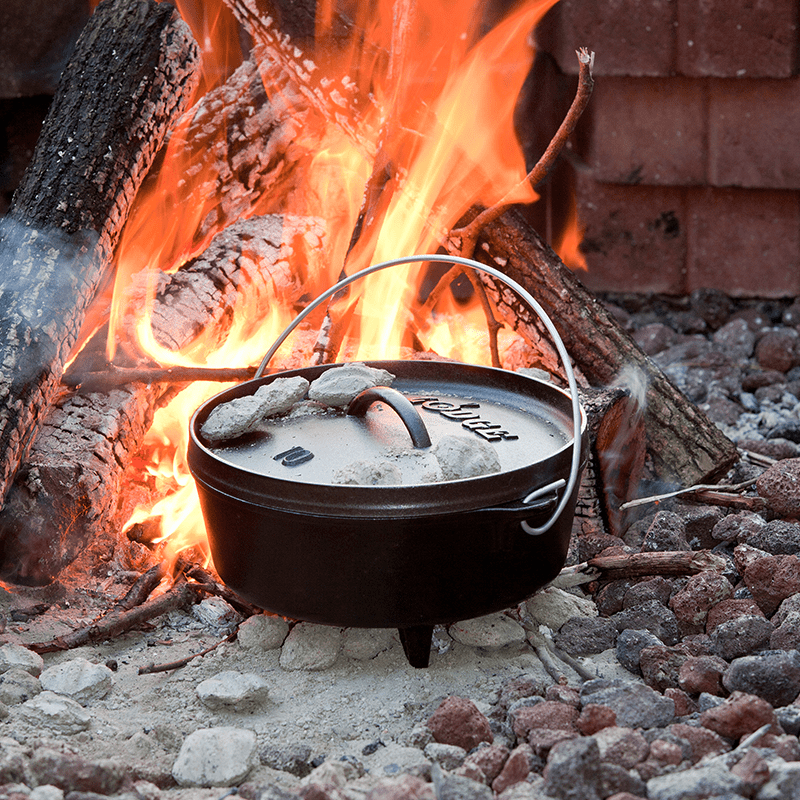Plenty of cookware looks good until you actually cook with it. One high-heat stir-fry and suddenly the non-stick flakes, the base warps, and the handle starts doing its own thing. You end up back where you started, shopping for yet another pan that promises performance but doesn’t quite deliver.
Cast iron is different. It doesn’t pretend to be lightweight or low-maintenance. It doesn’t need to. What it offers is real cooking power. It holds heat like nothing else, gives you an even sear every time, and lasts so long you’ll forget when you bought it. It’s one of the few things in the kitchen that genuinely gets better with age.
If you’ve ever been curious about cast iron but weren’t sure where to start, this is your no-nonsense introduction. We’ll cover what it is, why it works, how to season it properly, and how to make it part of your everyday kitchen routine. Whether you’re upgrading your cookware collection or starting from scratch, you’re in the right place.
What is Cast Iron and Why Is It so Popular?
There’s no secret formula behind cast iron. No multi-layered construction. No fancy coatings. It’s simply iron, melted down and poured into a mould, then left to set into something strong enough to handle decades of cooking without flinching. That’s it, and that’s the point.
Cast iron doesn’t try to be modern. It doesn’t need to. The same qualities that made it a staple in 19th-century kitchens still make it relevant now. What sets it apart is how it holds heat. Where lighter materials heat quickly and lose temperature just as fast, cast iron builds heat slowly and retains it evenly, making it ideal for high-heat searing, deep-frying, baking, and slow roasting.
There are two main types of cast iron cookware worth knowing about:
- Bare cast iron: Uncoated, requires seasoning, but develops a naturally non-stick surface with time. Ideal for high-heat cooking and baking.
- Enamelled cast iron: Coated with a smooth enamel glaze, doesn’t require seasoning, and is easier to clean. Excellent for stews, soups, and slow oven dishes.
You don’t need to choose between them. Many of our customers keep both a bare skillet for weeknight frying and an enamelled cast iron for anything low and slow.
Seasoning Your Cast Iron
One of the most misunderstood parts of cast iron cookware is seasoning. It’s often treated like a mysterious ritual, or worse, something only “serious” cooks bother with. But in reality, it’s dead simple and crucial if you’re using bare cast iron.
Seasoning is the thin, durable layer that forms when oil is heated on the surface of cast iron. Over time, it bonds to the metal, creating a blackened patina that gives your cookware its natural non-stick quality and protects it from rust. Think of it less like maintenance and more like building the pan’s personality.
Here’s how to season your cast iron properly:
-
Wash your pan with warm water and a small amount of dish soap (only do this the first time).
- Dry it thoroughly with a tea towel. Water is the enemy of seasoning. For flawless results, especially with skillets, heat your pan on the stove to evaporate all remaining moisture.
-
Oil it lightly with a high smoke-point oil like flaxseed, canola, or grapeseed.
-
Buff off excess oil with a clean cloth. The surface should look slightly shiny, not greasy.
-
Bake it upside down in a preheated oven at around 230°C for one hour.
- Let it cool inside the oven before storing or cooking with it.
Seasoning isn’t just a one-off task. Each time you cook with oil, especially at higher heat, you reinforce that layer. It gradually darkens, smooths out, and becomes more effective, which is why cast iron actually improves with age.
Cooking with Cast Iron
Cast iron rewards good habits, not perfectionism. You don’t need to baby it, and despite what some online advice suggests, it’s much harder to mess up than people think. Here’s how to cook with it properly (and actually enjoy the process).
1. Preheat the pan first
Cast iron takes time to heat up, but once it’s hot, it stays hot. Give it a few minutes over medium heat before adding anything. Cold food on a cold pan will stick. A properly heated pan sets you up for better searing, browning, and non-stick results.
2. Add oil once the pan is hot
Once the pan’s warm, add a light coating of neutral oil. Canola, grapeseed, or rice bran are great everyday options. The oil helps prevent sticking and reinforces the seasoning. A generous swirl won’t hurt.
3. Let the food cook
Once your ingredients go in, resist the urge to move them around straight away. Cast iron works best with good surface contact. Give it time to form that golden crust before flipping or stirring. You’ll know it’s ready when it releases easily.
4. Use any utensils you like
Wood, silicone, or metal, cast iron can handle them all. It’s not delicate. A stainless steel spatula is completely fine, especially when you need to scrape up those flavour-packed browned bits.
5. Don’t fear high heat
One of cast iron’s strengths is how well it holds heat. A hot pan can deliver restaurant-level sears and that unmistakable Maillard browning. As long as you’re not leaving it empty on full blast for 20 minutes, high heat is not a problem.
6. Finish in the oven if needed
Cast iron transitions beautifully from stovetop to oven. Use it for dishes that start with a sear and end with a roast (frittatas, baked pasta, crispy-skinned chicken thighs). No need to transfer to another dish.
How to Clean and Maintain Cast Iron
When it comes to cleaning cast iron cookware, people tend to split into two camps. On one end, you’ve got the purists who proudly refuse to clean their pan at all, claiming those crusty bits are part of the “seasoning”. They are not. That’s just last night’s dinner. On the other end, there are those who treat cast iron like any other pan, putting it straight into the dishwasher with a pod. That won’t end well either.
The right cleaning method depends on what kind of cast iron you’re working with. Bare cast iron and enamelled cast iron each need a slightly different approach, and treating them the same can cause more harm than good. The good news? Both are easy to care for once you know the basics.
Cleaning Bare Cast Iron
- Let it cool slightly: Warm is best, not boiling hot, not stone cold. Just cool enough to handle comfortably.
- Wipe out food residue: Use a paper towel or spatula to remove excess oil and crumbs. For anything stuck on, hot water and a firm brush usually do the trick. You don’t need to scrub like you’re sanding a deck.
- Skip the soap: Unless you're prepared to fully reseason your pan, skip the dish soap. Dry sea salt is a brilliant alternative as it’s tough enough to scrub away residue, yet gentle enough to leave seasoning intact.
- Avoid the dishwasher: This is the one hard rule. Dishwashers and cast iron do not mix. They’ll strip your seasoning and introduce rust a whole lot faster.
- Dry it thoroughly: Moisture is your enemy. Dry it with a tea towel, then place it on a low flame for a few minutes to drive off any remaining water.
- Re-oil lightly before storing: Once dry, rub in a thin coat of neutral oil. Just enough to protect the surface, not enough to make it feel greasy.
Cleaning Enamelled Cast Iron
- Let it cool slightly: As with bare cast iron, warm is best. Let it cool just enough to handle comfortably before cleaning.
- Wipe out food residue: Use a paper towel or spatula to remove crumbs and excess oil. For anything stuck on, warm water and a soft sponge usually do the trick. Again, be mindful of how hard you’re scrubbing.
- Use a gentle soap: Unlike bare cast iron, enamelled pieces don’t rely on seasoning, so a mild detergent won’t hurt. Just pair it with warm water and anything too abrasive.
- Avoid the dishwasher: Even enamelled cast iron doesn’t belong in the dishwasher. It can dull the enamel over time and isn’t worth the risk.
- Dry it thoroughly: Once clean, dry it well with a tea towel. There’s no need to re-oil or season. Just store it dry, and it’s ready for next time.
Our Cast Iron Top Picks
Think you’re ready for a cast iron? We’ve got options to suit every kitchen and every budget. From classic skillets to clever multi-taskers, here are five cast iron pieces we genuinely rate (and why).
-
Our Affordable Pick: Lodge Cast Iron Skillet 16.5cm
Perfect for solo cooks, side dishes, or serving something sizzling straight to the table. This compact skillet proves you don’t need to spend a fortune to get into cast iron cooking. Pre-seasoned with 100% natural vegetable oil and ready to go, it’s great for eggs, small bakes, or toasting spices. A top pick for first-timers or anyone with a small stovetop footprint.
-
Our Everyday Pick: Lodge Cast Iron Skillet 26cm
The classic cast iron pan that does it all. Big enough for family meals, tough enough for high-heat cooking, and simple enough for everyday use. Perfect for frying, baking, roasting, and everything in between. This is the pan you’ll use more than any other.
-
Our Multi-tasker Pick: Lodge Combo Cooker 26 cm
Two pans, three functions, one clever design. This combo includes a deep Dutch oven and a shallow skillet that doubles as a lid. Bake sourdough, simmer soups, sear steaks, or do it all at once. A brilliant choice for cooks who love flexibility and hate clutter.
-
Our Premium Pick: Le Creuset Signature Cast Iron Skillet 30cm
For those who want performance and polish. This 30cm Le Creuset skillet is enamelled inside and out, so there's no need to season (and no fuss to clean). It delivers even heat, superb searing, and looks beautiful straight from stove to table. A luxury piece that earns its place in any serious kitchen.
-
Our Design Pick: WMF Flavour Round Roaster 24cm
Sleek, elegant, and built to last. WMF’s cast iron roasters combine German engineering with contemporary design. The 24cm round roaster is perfect for one-pot meals, braises, and weekend roasts. Excellent heat retention, a durable enamel finish, and a more refined aesthetic for modern kitchens.
Ready to Upgrade Your Kitchen?
Cast iron isn’t just a trend. It’s the tool serious home cooks keep coming back to, not because it’s flashy, but because it works. Whether you’re frying eggs or baking sourdough, hosting a roast or just reheating leftovers, a good cast iron pan holds its own, day after day, year after year.
If you’re new to cast iron, start simple. If you’re upgrading, invest in something that earns its place on the stovetop. Either way, we’ve got the gear, the brands, and the know-how to help you get cooking confidently.
Explore our full cast iron cookware range, or visit us in-store to see it all in action. Your next favourite pan is probably waiting.



